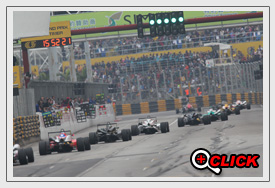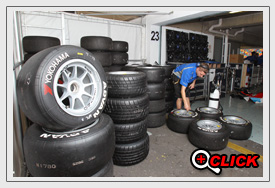This coming meeting is the 60th edition of Macau Grand Prix since its long history started in 1954. The origin of the event was a four hour automobile race in the Portuguese colony which was rapidly growing by overseas trade in those days. After the successful first meeting in which 15 competitors took part, the scale of the event expanded with each passing year. Since then it has become to be considered as an important international race event and to attract much attention from around the world, as not a few racers have acquired the stature of legend by their performance in Macau.

In recent years, Macau Grand Prix consists of a wide variety of car and motorcycle races, with the two major categories, Formula 3 Grand Prix Race and Guia Race for touring cars, at the top of them.
Formula 3 replaced the preceding car regulations for the Grand Prix in 1983. Yokohama Tire has been the sole tire supplier for the Macau F3 Grand Prix since its first year and the company celebrated the 30th anniversary milestone as the Grand Prix's official supplier last year.
Since the top contenders from the Formula 3 championships around the world gather in Macau and race each other very hard, the Grand Prix is often called as the race to decide the F3 world champion. With late Ayrton Senna, the winner of the first F3 Grand Prix in 1983, at the top of the list, many racing drivers have boosted their careers by good results in Macau on their way to Formula 1 or other professional race categories. Therefore, the Grand Prix is one of the key stepping stones to success for the promising young drivers.
Guia race is run as the season finale of the FIA World Touring Car Championship series. In the past, a lot of legendary battles by the tin-top cars were seen in Macau because the races were often fought as the championship showdowns. Yokohama Tire has also been the official tire supplier of the world championship since 2006.
In addition to these two top categories, the GT Asia series that tours around the Asian countries, using the FIA GT3 cars, also rely on Yokohama Tire as the sole tire supplier for the series. Even in other categories that the competitors have freedom of choice about tires, many of leading drivers and teams choose the Yokohama's products for success. In short, Yokohama Tire has been one of the essential partners of Macau Grand Prix for years and it can be said that the banners of the official tire supplier for the F3 and Guia race are the basso continuo of the race weekend.

In this year's 60th edition of Macau Grand Prix, the event will span two
weeks to accommodate 13 race categories in which about 350 racers from
38 countries will take part. The number of competitors increases by almost
50 % from the last year's 221.
According to the organizing body, Macau Grand Prix Committee, the total budget for this year's event will be around 300 million pataca (37.5 million US dollar), including the cost to build a new race control tower which will become a symbol of the ever evolving Macau Grand Prix.